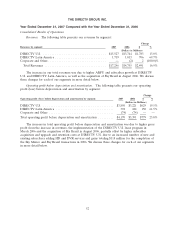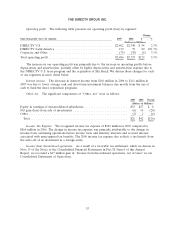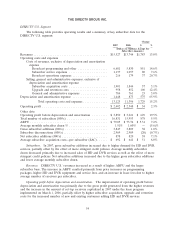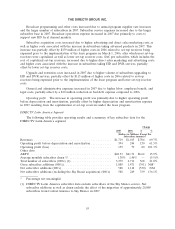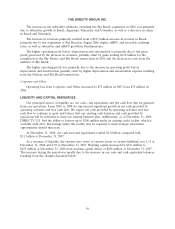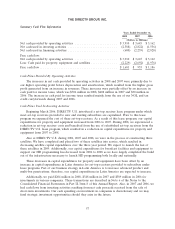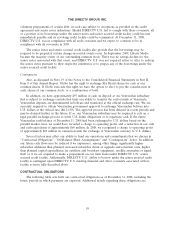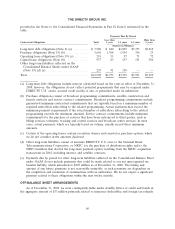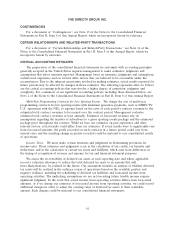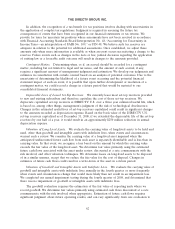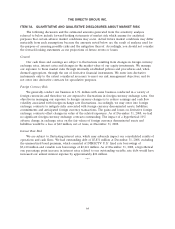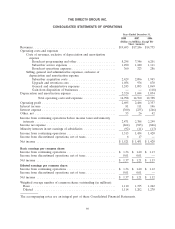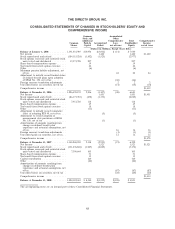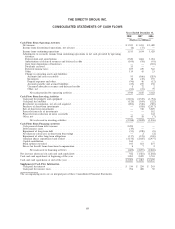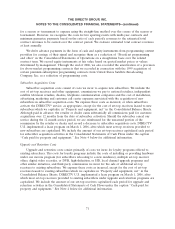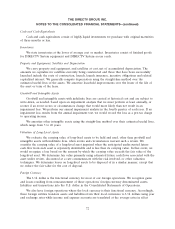DIRECTV 2008 Annual Report Download - page 75
Download and view the complete annual report
Please find page 75 of the 2008 DIRECTV annual report below. You can navigate through the pages in the report by either clicking on the pages listed below, or by using the keyword search tool below to find specific information within the annual report.THE DIRECTV GROUP, INC.
In addition, the recognition of a tax benefit for tax positions involves dealing with uncertainties in
the application of complex tax regulations. Judgment is required in assessing the future tax
consequences of events that have been recognized in our financial statements or tax returns. We
provide for taxes for uncertain tax positions where assessments have not been received in accordance
with Financial Accounting Standards Board Interpretation No. 48, ‘‘Accounting for Uncertainty in
Income Taxes—an interpretation of FASB No. 109,’’ or FIN 48. We believe such tax reserves are
adequate in relation to the potential for additional assessments. Once established, we adjust these
amounts only when more information is available or when an event occurs necessitating a change to the
reserves. Future events such as changes in the facts or law, judicial decisions regarding the application
of existing law or a favorable audit outcome will result in changes to the amounts provided.
Contingent Matters. Determining when, or if, an accrual should be recorded for a contingent
matter, including but not limited to legal and tax issues, and the amount of such accrual, if any,
requires a significant amount of management judgment and estimation. We develop our judgments and
estimates in consultation with outside counsel based on an analysis of potential outcomes. Due to the
uncertainty of determining the likelihood of a future event occurring and the potential financial
statement impact of such an event, it is possible that upon further development or resolution of a
contingent matter, we could record a charge in a future period that would be material to our
consolidated financial statements.
Depreciable Lives of Leased Set-Top Receivers. We currently lease most set-top receivers provided
to new and existing subscribers and therefore capitalize the cost of those set-top receivers. We
depreciate capitalized set-top receivers at DIRECTV U.S. over a three year estimated useful life, which
is based on, among other things, management’s judgment of the risk of technological obsolescence.
Changes in the estimated useful lives of set-top receivers capitalized could result in significant changes
to the amounts recorded as depreciation expense. Based on the book value of the DIRECTV U.S.
set-top receivers capitalized as of December 31, 2008, if we extended the depreciable life of the set-top
receivers by one half of a year, it would result in an approximately $250 million reduction in annual
depreciation expense.
Valuation of Long-Lived Assets. We evaluate the carrying value of long-lived assets to be held and
used, other than goodwill and intangible assets with indefinite lives, when events and circumstances
warrant such a review. We consider the carrying value of a long-lived asset impaired when the
anticipated undiscounted future cash flow from such asset is separately identifiable and is less than its
carrying value. In that event, we recognize a loss based on the amount by which the carrying value
exceeds the fair value of the long-lived asset. We determine fair value primarily using the estimated
future cash flows associated with the asset under review, discounted at a rate commensurate with the
risk involved, and other valuation techniques. We determine losses on long-lived assets to be disposed
of in a similar manner, except that we reduce the fair value for the cost of disposal. Changes in
estimates of future cash flows could result in a write-down of the asset in a future period.
Valuation of Goodwill and Intangible Assets with Indefinite Lives. We evaluate the carrying value of
goodwill and intangible assets with indefinite lives annually in the fourth quarter or more frequently
when events and circumstances change that would more likely than not result in an impairment loss.
We completed our annual impairment testing during the fourth quarter of 2008, and determined that
there was no impairment of goodwill or intangible assets with indefinite lives.
The goodwill evaluation requires the estimation of the fair value of reporting units where we
record goodwill. We determine fair values primarily using estimated cash flows discounted at a rate
commensurate with the risk involved, when appropriate. Estimation of future cash flows requires
significant judgment about future operating results, and can vary significantly from one evaluation to
62


